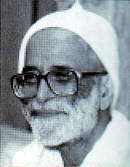
Jaina Convention
Federation of Jain Associations In North America
Prayer And Its Power
 Pujya Shri Atmanandji Shrimad Rajchandra Adhyatmik Sadhana Kendra Koba, Dist. Gandhinagar, Gujarat, India Pujya Shri Atmanandji was formerly known as Dr. Soneji. He is a well respected spiritual leader and this article is a piece from his research work on the Power of Prayer. |
A prayer may be defined as the universally accepted mode of communication between the devotee and the Divine, practiced in all religious traditions.
PREVALENCE OF PRAYERS:
Regarding its prevalence, we find prayer to be universal and international because no elaborate preparations, either in the form of materials or in the form of its method of implementation, are required. The Almighty will always listen to me even if I were illiterate or a pauper or ugly or otherwise downtrodden. He has no distinction among His devotees regarding race, religion, nationality, caste, creed, color or any other external criteria. The only real instrument required to approach Him is divine love, untainted by selfish motive or falsehood. In its pure spiritual form, it is the pouring out of our hearts before God. An important point to note here is that all great men of the world pray to God. Even those saints who have attained a very high spiritual state also pray to Him and spend decades of their lives in the eulogy of the Divine. This is the case of the great sage Maharshi Vyas in the Hindu tradition who wrote Shrimad Bhagvata, and Acharya Jinsen-I & Acharya Hemchandra who wrote respectively Mahapurana and Vitrag-Stava, in the Jain tradition.
FORMS OF PRAYERS:
The three main ways to approach the Divine are physical, vocal and mental prayers.
- Physical Prayer:
This is in the form of adoration, bowing before the image and performing the ritual called Pooja with various materials such as water, flowers, sandalwood, incense burning, waving of lights before the deity and so on. Other non-verbal forms of prayers include dance, food-offering, etc.
- Vocal Prayer:
This is the main form of prayer. It may be in the form of prose or poetry; very short in the aphoristic form of Mantra, medium in the form of Stotra (psalm or hymn) or quite elaborate as in Pooja. In all these forms, the devotee invokes purer thoughts in his mind through the medium of sound. These thoughts have close cause and effect relation with sublime emotional feelings in the human mind.- Mental Prayer:
This is the highest form of prayer from the spiritual point of view; and is usually carried out silently along with the different forms of meditation and contemplation. The practice of this form is possible for an advanced aspirant who is well versed in right spiritual tenets, and has good control over his mind and senses. Normally, when the prayer begins, it is vocal in nature and subsequently, when the mind of the aspirant becomes steady, the vocal aspect ends and the silent prayer takes over.
TYPES AND CONTENTS OF PRAYERS:
There are many types of prayers with differing contents. The four main types are praising, dedicating, confessing and community prayers.
The devotee may praise the external form or inner virtues of God. How Saint Tulsidas describes Lord Rama is an example of praising God in external form. The devotee may glorify and concentrate on the inner virtues of God like infinite knowledge and bliss, as Pujya Gnanvimalsuriji describes the internal glory of Lord Adinath (Rushabhdev).
In accordance with one's spiritual development, the approach to the Divine may be monotheistic or polytheistic and the external object may be in the form of a photograph, painting, carving, idol or scripture and is only a means of support and inspiration. Intense love for divine virtues burns away the shortcomings and worldly passions of the devotee. It makes him pure so that the Divine Grace descends more readily upon him. These are considered as positive prayers and are usually joyous and uplifting. With advanced spiritual experience, all the differences of personal, impersonal, formless and incarnate disappear. Then at last, the worship, the worshipper and the worshipped all merge into one divine, ineffable mystic experience which represents the summum bonum of achievements in spiritual life
An example of this type of prayer is Kshamapana (asking forgiveness) in the 56th lesson of Mokshamala by Shrimad Rajchandra, the spiritual guide of Mahatma Gandhi. A partial translation is given here."Oh God! I forgot, wandered aimlessly, rambled here & there and I am caught in the snare of transmigratory worldly life. I am sinful, intoxicated with pride and my soul is defiled with the dust of my Karmas. I am always engrossed in the machinations of worldly life and I have been blinded by ignorance. I have no discretionary power, and so I am foolish."
SUMMARY:
The purpose of prayer may be summarized as the most universally accepted form of worship for one's own spiritual benefit, as well as a vehicle for goodwill, harmony, peace and universal well-being of mankind. It contributes towards peaceful coexistence among nations and between peoples. It was, is, and will remain one of the most prevalent instruments for self-improvement and for the betterment of society. While uplifting spiritually, the power of prayer spreads peace on earth and goodwill towards all.
 Pujya Atmanandji
Pujya Atmanandji